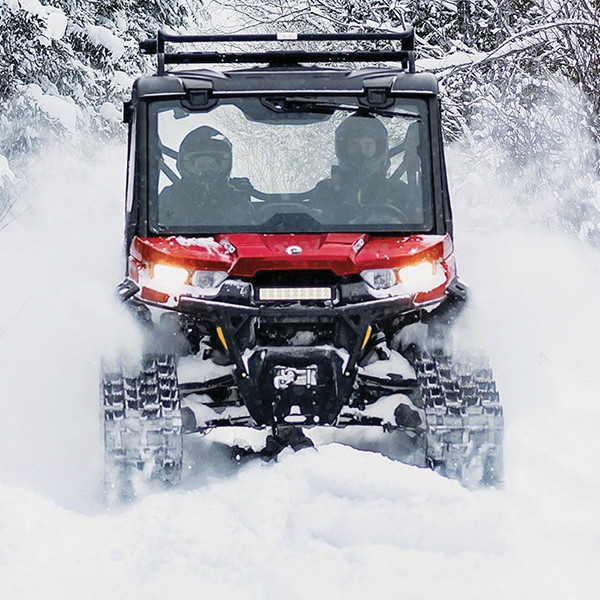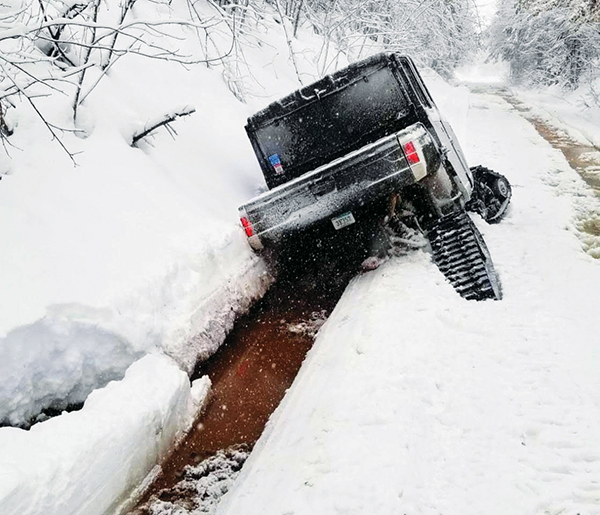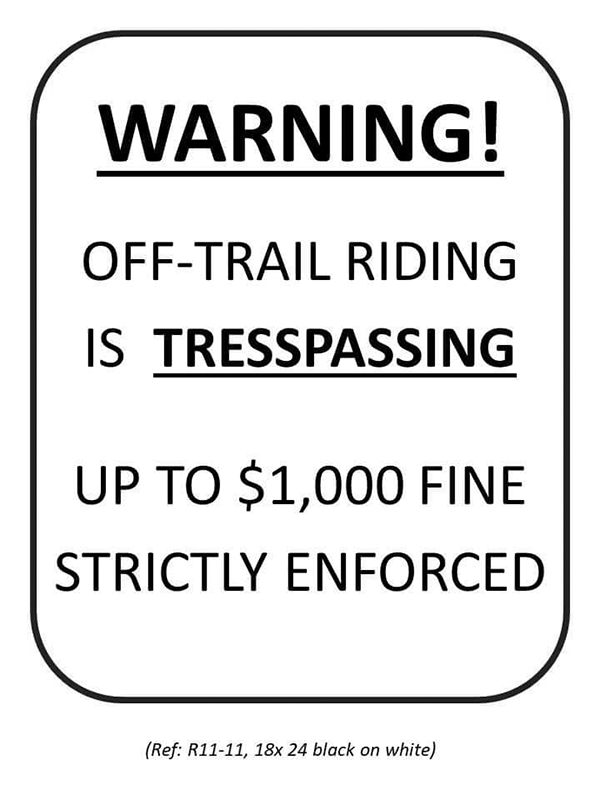By Jim Duke
Everyone who knows me also knows I’m an avid snowmobile enthusiast and have been for more than four decades. I must admit, however, that in my younger years I did ride motorcycles and at one time owned a Honda three-wheeler with tires fatter than my big beer belly, which I rode in the abandoned quarries near my home downstate. As much fun as that was, I never developed the kind of passion for it that I have for snowmobiling.
That being said, however, during the past couple of years I’ve been introduced to a more modern form of four-wheeling and have really enjoyed the experiences, but more so with the side-by-side UTV’s rather than the ATV type vehicles. I must confess that while riding on some of the same trails in the summertime as I do in winter months, the scenery is as much different as are the temperatures, but there are other differences as well.
For example, during snowmobile season, there are no bugs, no mosquitos or black flies, and snow dust is much more tolerable than the dirty kind. Perhaps that is why I also enjoy the summer fun at a much slower pace than when I’m on my snow machine. Distancing isn’t much of a problem during snow season, and when riding with others is primarily governed by visibility whereas under similar conditions in the warmer months, remaining a significant distance behind the units ahead is governed not by visibility, but by breathability.
Also, though possible to encounter a wet area occasionally during the winter months, it is not a question of if while four-wheeling, but when and where it might occur. The few times I’ve been privileged to accompany friends in their side-by-side UTV’s, on every trip we have found an abundance of water spots on the trails, some passible and some not. Which brings to mind one other similarity between ATV riders and snowmobilers.


Almost every experienced snowmobiler has a tow strap in their sled, which is very useful if, and when, they get stuck or if their snow machine malfunctions. Almost every ATV and UTV has a winch attached for the same purposes. The major difference is how often one is required versus the other. I have personally witnessed ATV’s literally sink almost out of sight in what the rider assumed was a shallow puddle of water, and without that winch, would have been disabled for an undetermined amount of time.
The one safety issue that both the snow riders and the dirt riders have in common is, or should be, to never, repeat NEVER, go on any adventure alone! It is generally understood that if one stays on the designated trails other riders will eventually come along and will usually offer assistance. The question is, when?? Time of day, lack of food, water, fuel, map, a GPS, cell service, or even being unfamiliar with location can be a scary situation if out in the forest alone.
1. A single rider with a stuck snow machine is subject to many health issues, in fact too many to mention here other than the most severe. Over exertion by trying to dig it out could bring on a heart attack, or failure to properly dress for the freezing temperatures could lead to hyperthermia, both conditions could become deadly, and even the healthy individuals are, or can be, as much at risk! A basic rule taught in every snowmobile safety class is, or should be, the fact that a snowmobiler can ride further into the wilderness in just fifteen minutes than it takes to walk out in a day… keeping that in mind should be a primary concern of every winter enthusiast. The same can, and should be, easily applied for all seasons.
In the warmer months of course, one doesn’t usually think of life-threatening situations that are prevalent during the winters, but there are a few things to be concerned about just the same. For example, wildlife is more abundant and more dangerous. Bears most generally come out of hibernation sometime in the early Spring with a hunger that is out of control, and the vast majority are not choosy about what they eat, or where they find it. And although wolves rarely sleep through the winters, they are generally much more active when the temps are above the freezing mark and the snow has melted, making prey easier to detect and catch.
In conversations with some of my longtime snowmobiling companions that have recently gave up the winter recreation for the warmer ones, they tell me it was not which was most enjoyable but rather which they could enjoy for the longest period of time, and quite honestly, the least expensive. A recent review of the latest snowmobile models has entry level sleds priced anywhere from $8,000 to $10,000 and top of the line performance snow machines at, or very near, $20,000. As much as the prices have changes over the past several decades, the length of the season has not!

With a good year, the snowmobilers may be able to ride on the official opening day of December 1st, but that has been a rare occasion lately indeed. And regardless of how much snow is still on the ground come March 31st, the season officially ends, no more grooming of any trails is authorized, and leased private lands where trails cross becomes off-limits. But the snowmobilers haven’t had a good season for several years. At best the usual sixteen week season may provide adequate snow depths for only about half of that.
On the flip side, however, in recent years as popularity of off-road use has increased, so has the infringement of wheeled vehicles onto the dedicated snowmobile trails before the season has officially ended, which has caused some serious conflicts between trail users. Not only do the wheeled vehicles cause irreparable damage to the trail surface and a serious safety issue for the snowmobile riders, but they also create animosity among local residents, the trail sponsors, and the landowners by trespassing onto private properties, even though it wasn’t due to a fault by any of those themselves. With trespassing becoming a major issue lately, not only for snowmobilers but for all trail user groups, where do we place the blame?
2. If fault must be applied to that particular cause, the majority of those interviewed say it lies with the passage of Public Act 288 (PA 288) by the Michigan Legislature, and how it has been interpretated, or better yet, misinterpreted by the vast majority of those who seek greater freedom to wander in the woods via ORV without any period of restriction. Briefly, PA 288 was enacted in 2016 and required the Department of Natural Resources to inventory and map all forest roads in all state forests within Michigan, as well as any others under DNR jurisdiction. As a result of that order, approximately 90% of state forest roads inventoried to date have been opened to ORV use, including many that are considered “seasonal”, are unplowed during the winter, and have been previously designated exclusively as a snowmobile trail.

Whether it through confusion or just a blatant disregard, many ORV operators choose to ignore the part of the Act that pertains to “Roads Closed to ORV’s”, either due to necessary protection of a natural resource or because of user conflicts. The big rub comes, obviously, during the designated snowmobile season when thousands of dollars are expended to maintain and groom these roads / trails with the funding coming from the Snowmobile Program, only to have wheeled vehicles drive over them and leaving ruts that, in many cases, cannot be repaired and creates an unsafe condition for snowmobile riders.
Visible posting of “NO WHEELED VEHICLES” signs at almost every possible entry to the snowmobile trails has not had a significant impact thus far. Likewise, private property owners have said the posting of NO TRESPASSING signs has been a useless endeavor. This applies to snowmobilers as well, and complaints are constantly received, even with the “STAY ON TRAIL” signs clearly displayed at such locations.
In order to develop a continuous snowmobile trail system it is sometimes necessary to cross privately owned properties, and is achieved through agreements between the landowners and the trail sponsors, sometimes by lease of an easement and for a specific period of time. The usual period begins December first of each year and ends at midnight on the last day of March. Use of any trail on private property at any other time is considered trespassing and violators, when apprehended, can receive a citation and be fined.
In summary, the number of avid snowmobilers continues to decrease, either due to excessive expense or the limited time to enjoy the season, sale of ORV’s continues to grow, and user conflicts will continue to be an issue not easily resolved. In a perfect society, users in each category would respect the seasons and not encroach on each other, but unless the authorities intervene with restrictions similar to those imposed during firearms hunting season where neither ORV or snowmobile may be operated on all public lands during daylight hours except at specific times, such problems will continue to exist, and to date no one has recommended such an option.
Snowmobile season is just four months long at best. The dirt riders have the rest of the year to enjoy the woods. Why can’t we all just play nice together? •



